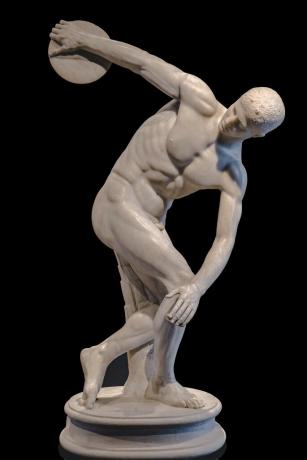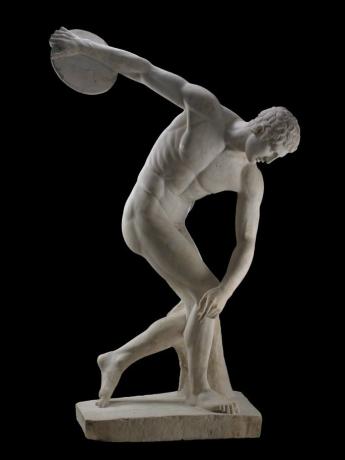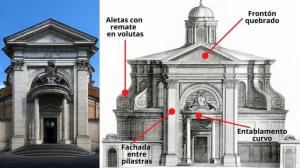Myron's discóbolo: characteristics, analysis and meaning of Greek sculpture
The sculpture known as the Myron's discobolus It is part of the great treasures of the art of Classical Antiquity, along with pieces such as the Victory of Samothrace, Laocoon and their children and the Venus de Milo. Attributed to the sculptor Mirón de Eleuteras, it is probable that the Discobolus It was originally made in bronze around 450 BC. C.

Roman marble copy found in 1781 (copy also known as Lancelotti's discobolus).
The knowledge of this sculpture has come to us through Roman copies. The best known and best accomplished of these copies was executed in marble and is currently in the National Roman Museum in Italy. This and the other copies allow us to have an idea of what the original sculpture could have looked like. Let us know its main characteristics, its function and its meaning.
Analysis

The discobolo
It is a sculpture with a round shape that represents an athlete just at the time of preparation for the throwing of the discus, one of the athletic competitions handed down from classical antiquity.At the base of the sculpture, we can see a trunk like a palm tree, which the artist has left there to serve as a support for the piece.
The representation supposes the moment of the maximum mental and physical concentration of the athlete in question. The body flexes in preparation for the launch. The athlete prepares to throw with all his force the disc that will follow the line of the right leg after the movement of the well balanced and arched arms.
The arms expand like propellers, implying the search for balance in the movement as well as the dynamic impulse. These outstretched arms form a semicircular line that begins at the disc and ends just in the athlete's left hand.

In this way, the athlete's body prefigures a kind of bow with his arms and the inclination of his legs, announcing the tension that the launch will allow. Likewise, the forward bending of the torso, together with the bending of the legs, forms a sinusoidal line that goes from the tip of the head to the tip of the foot.
However, there are no recognizable signs of exertion on the face. On the contrary, the athlete has a serene face, without emotion or tension, as if that activity did not represent a significant force. The expressionlessness of the face contrasts with the details that the sculptor enhances in the athlete's body. We can see the muscle tension, the bulging veins, the bust, the ribs and some joints.
For the art historian Ernst Gombrich, the sculptor has put into practice a resource inherited from Egyptian art, although the original piece is perfectly framed in the Greek classical period (5th century BC) C.). We note that the sculptor has left his shoulders in a frontal position while his lower extremities are in profile, as if it were a sculptural transposition of the principles of painting Egyptian.
Along with this, Gombrich highlights the contrast that means the detailed anatomical work that he applies the sculptor in the hands of the figure, which breaks the Egyptian hieratic evoked in the visual general. Certainly, the sculptor has been a master in convincing us of the naturalness of a posture that does not correspond to reality.
Meaning
The serenity and seriousness of the face reveals the intentions of the sculptor Mirón: to represent not a feeling, but a ideal of perfect beauty, which is expressed in symmetry, proportion and balance of the human body as a whole, as corresponds to the plastic values of the classical Greek period.
The piece reveals the main interest of Greek artists: imitation (observation) of nature on the one hand, and admiration and study of the human body for the other.
In Greek art deprives the construction of an ideal beauty, a model of perfection, on the principle of historical memory of a particular individual. The Greeks imitate the forms of nature and perfect them. That is why in this period, despite the fact that the sculptures may allude to some personality, they are not portraits but allegories.
The discobolo would not represent an athlete but the athletic ideal. Such was the social and cultural importance of the Olympic games and athletic competitions in general for that generation. The discobolus, word meaning 'discus thrower', doubly confirms the valuation of the human body for the Greeks, both for the theme of representation (athletics) and for the plastic composition.
Other interpretations, less widespread and accepted, relate to the Myron's discobolus with the story of the hero Jacinto or Hyakinthos, lover of the god Apollo. There are two versions in mythology. One relates that Jacinto would have caused his own death by clumsily throwing a disc and accidentally but fatally injuring himself. Another version indicates that the accident would have been caused by Apollo. From the blood spilled by the hero would flow hyacinth flower.
Copies and versions of Mirón's Discobolus

For those who are new to art history, it can be confusing to come across various sculptures from the Myron's discobolus, which show noticeable differences between them. This happens because the original piece, probably made in bronze, has been lost.
However, the Romans were great admirers of Greek art, and during its expansion, they frequently devoted themselves to the replication in marble of great masterpieces of Hellenic culture, thanks to which today there are different versions.
Some copies are better known than others. The first copy discovered was the so-called Lancelotti, found in Villa Palombara owned by the Massimo family in 1781. It is the one that is in the National Roman Museum of Italy and the one that we have taken as a reference for this analysis.
In 1790 another copy in Hadrian's Villa in Tivoli, which is part of the collection of the British Museum. In a restoration process, the head was oriented in the wrong direction.

The unique fame of the discóbolo also made him the object of re-readings and innovations. It is not strange to find works of contemporary art that refer to this piece. This is the case, for example, of the work Cosmic athlete by Salvador Dalí, made in 1968.
It may interest you: Venus de Milo sculpture
References
- Gombrich, Ernst (1989), History of art, Mexico: Diana.
- Official website of the Gala-Salvador Dalí Foundation: Cosmic athlete. Recovered from salvador-dali.org.
- British Museum Official Website: The discobolo. Recovered from britishmuseum.org.



